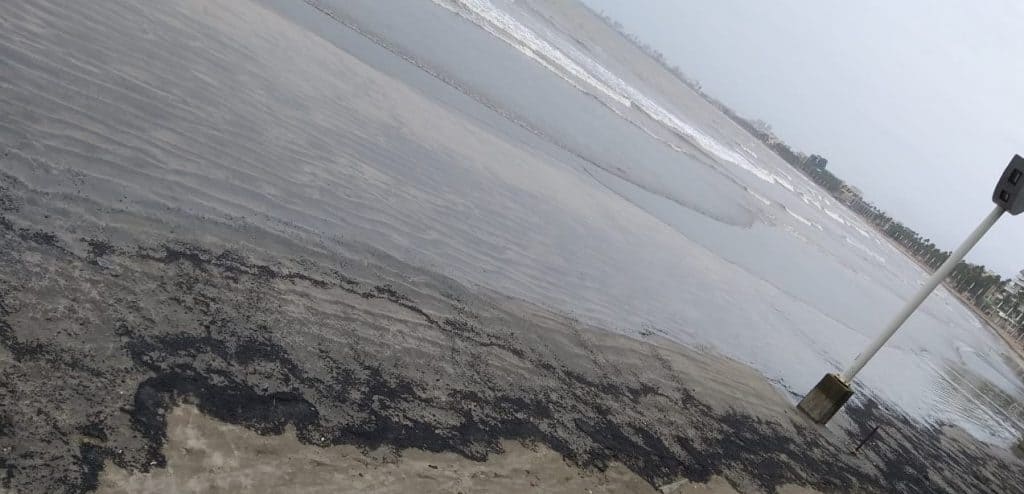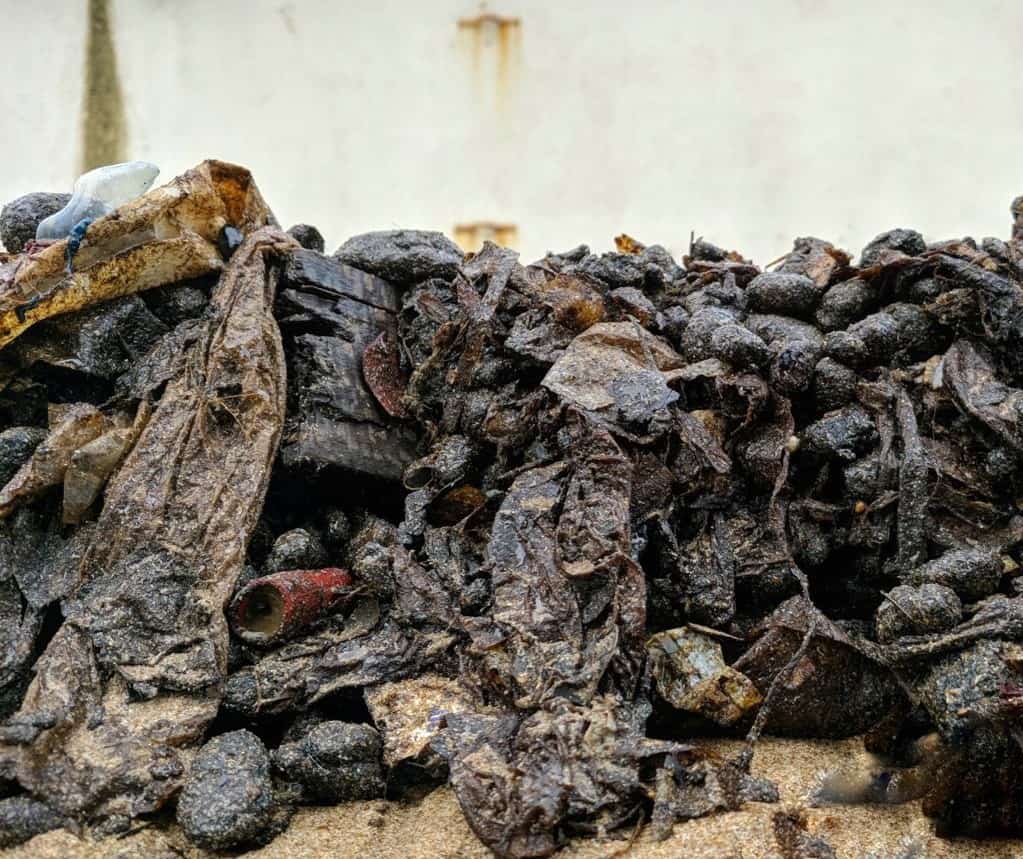Oil spills are annual during Mumbai monsoons and this year was no exception. Washed ashore as black or dark brown sticky liquid tar deposits, it was first noticed on August 4th that the sand in several beaches of Mumbai turned black from the tar deposits. These signs of tar pollution were seen along a stretch of 4 kilometres, extending up to Alibag and beaches in Palghar.
In fact, according to Shaunak Modi, Director, Coastal Conservation Foundation, the oil deposits have been occurring throughout August. Two weeks ago a lot of tar had washed ashore at Chimbai beach in Bandra and the Brihanmumbai Municipal Corporation (BMC) is cleaning up the tar twice a day, added Modi.
Washed ashore as black or dark brown sticky liquid tar deposits, this is usually the result of crude oil discharge into the sea. The tar that washes up on the beaches have, for years, wreaked havoc on the lives of sea creatures and onshore communities.
“We had pressed several teams on the beaches that reported the presence of tar,” said Prithviraj Chavan, assistant municipal commissioner at K-West ward, BMC.
“To avoid problems for visitors, the staff kept cleaning the beaches whenever high tides washed the tar ashore. Initially, cleaning up all the oil collected along the 5-kilometre coastline took a lot of labour and time. We withdrew the extra manpower as the amount of oil deposit washing up with the seawater gradually reduced over the next 4-5 days,” he added.
When asked if a sand sample was sent for testing before this year’s tar clean-up drive, Chavan said he had no such instruction from higher authorities. Although he couldn’t confirm the source, he stressed that concerned departments should proactively probe similar occurrence in the future.
Speaking on the latest occurrence of tarballs along Mumbai’s coastline, Mumbai Mayor Kishori Pednekar said usually sand is put over it and that she would assign a ward officer to inspect the source.
What are tarballs and why are they harmful?
Spills from oil vessels, oil well blowouts, accidental and deliberate release of dirty water from ships, and industrial effluents, often pollute oceans with petroleum. This crude oil floating in the sea gets weathered through evaporation and oxidation and washes up ashore in the form of sticky oil-emanating balls, called tarballs. Comprised majorly of hydrocarbons, these balls are also formed when oil mats formed on the seafloor by oil spills break down into smaller pieces.
Read more: City Buzz: Oil spill in Juhu Beach…and other news
While most tarballs are coin-sized, some measure up to 6-7 kilograms. The residence time of one such ball in the sea may vary from a few months to one year, and can have regional variations based on environmental conditions.
“Onshore invertebrates such as crabs, snails, and polychaete worms often get stuck in tarballs,” said Harshal Karve, a marine biologist at Mangrove Foundation, Mumbai. “Oil spills in shallow water hugely harm benthic animals – creatures living on the seafloor – as they are mostly immobile or slow-moving and therefore, fall prey to oil pollution.”
The crude oil present in coastal waters can harm intertidal fauna and seaweeds. Fish eggs and larvae on the sea surface can be at risk because of exposure to higher concentrations of water-soluble constituents leaching from floating oil.
While some sea animals might die from the contamination, others can retain the toxic hydrocarbons and cause further damage by entering the human food chain. An American study shows tarballs contain the human pathogen Vibrio vulnificus. Exposure to them through wounds can cause severe skin infections and even cause death.

Where are tarballs found in India?
Several studies by the National Institute of Oceanography (NIO) suggest India’s northwest coast is prone to tarball deposits during the southwest monsoon season, especially the Mumbai-Gujarat coast.
Tarballs have been found on the beaches of Goa since the 1970s, shows a 2013 paper by the NIO. In 1975 and 1976, the total deposit of them along the west coast was 1,000 and 750 tons respectively. As per the paper, possible sources causing tarball pollution along the west coast are tank washings from oil tankers returning from Mumbai port, oil handling ports along the Gulf of Kachchh, Asia’s biggest ship-breaking yard, the Alang-Sosiya Ship-Breaking Yard (ASSBY) in the Gulf of Cambay, oil transportation and tanker operations in the Red Sea and Persian Gulf, and barges, ships and tankers visiting Goa’s Mormugao port.
Another key reason highlighted in the paper is oil leaks from Mumbai High, the largest offshore oil-producing field of India, from where significant spills are observed during operations or accidents throughout the year. It also cites the Jamnagar oil refinery in the Gulf of Kachchh, Asia’s largest, as one of the possible sources for oil spills. The circulation pattern and surface winds along the west coast during summer monsoons further favour the transport of tarballs to the beaches.
Since when did Mumbai’s coastline start receiving tarballs?
The first major oil spill near Mumbai was in May 1993 when the rupture of a feeder pipeline in Bombay High spilled 3,000-6,000 tonnes of crude oil into the Arabian Sea. This was the first time Mumbai’s beaches reported a significant presence of tarballs.


The second incident was in 2005 when a multipurpose support vessel Samudra Suraksha collided with one of the four platforms of Bombay High. This was followed by the 2010 collision of Panama-flagged MSC Chitra with MV Khalijia, spilling over 800 tonnes of oil. In 2011, a cargo ship MV RAK Carrier sank nearly 20 nautical miles off the Mumbai coast. All these events led to regular occurrences of tarballs on Mumbai’s beaches, causing environmental harm and panic among residents and fisherfolk.
In 2018, large patches of Juhu beach were covered in tar on several days of July and August; even the garbage washing up ashore was covered in oil. Again in 2019 and 2020, tarballs were found on Mumbai’s beaches during the monsoon.
“This year, tarballs were found on several of Mumbai’s beaches – Juhu, Versova, Dadar, and Kihim in Alibag,” said Modi, who has been documenting tar pollution along Mumbai’s coastline for the last 3 years. “Traces of tar were also present in Bhuigaon beach at Vasai and other coastal areas of Palghar district.”
Read more: “For long, authorities have been unconcerned and apathetic about Mumbai’s ecology”
Source of tarball pollution in Mumbai goes untraced for years
In a 2014 study ‘Source investigation of the tarballs deposited along the Gujarat coast, India, using chemical fingerprinting and transport modeling techniques’, the NIO found that the Bombay High north oil fields had caused tar pollution on the beaches of Gujarat – Tithal, Maroli, Umbergam and Nargol – in July 2012. A similar study conducted in 2013 for tarball deposition in Goa too suggests Mumbai High as the possible source.
The source of tarballs on Mumbai’s beaches, in recent years, however, remains untraced. Detailed analyses were conducted by National Environmental Engineering Research Institute (NEERI) only after the 2010 ship collision and sinking of MV RAK Carrier in 2010.
Tar ball pollution in Mumbai’s beaches has been more widespread over the last few years, but there is little acknowledgement of the problem by the BMC and the Maharashtra Pollution Control Board (MPCB).
Vanashakti, a non-profit environmental NGO, filed a complaint in 2019 with the Maharashtra government and fisheries department demanding a stricter probe into the source of tar pollution. The MPCB at that time had said that most of the oil was coming from large cargo vessels beyond 12 nautical miles, moving parallel to the coast and that appropriate action would be taken only if the quantity increased.
“When the impact is this widespread, government bodies need to stop normalizing this [tar pollution] as a seasonal phenomenon. There have been few studies by government bodies on tar ball pollution in Goa and Gujarat but nothing significant in Mumbai. Samples should be collected here as well and be sent for thorough testing,” said Modi.
Sea animals and Mumbai’s residents pay the price
Tarball pollution has varied implications, affecting citizens, vendors and fisherfolk who depend on the city’s coastline. Most vulnerable are marine animals. “
In 2019, Karve and his team had spotted a dead turtle on Juhu beach. “On performing an autopsy, we found that the turtle had crude oil filled in its throat and intestines. Several portions of the Juhu beach had tarballs during the same time,” he said.
Fishermen have found tarballs stuck in their nets, and recently, fishermen at Palghar complained of difficulty in fishing due to their large presence on the beach and in the mangroves.
Mumbai beaches are inaccessible during monsoon months to locals, who cite foul diesel-like odour during this period as a reason. The oil spillage makes it impossible for them to walk on the beaches. Otherwise popular tourist sites, this poor footfall directly harms vendors, but despite this, the hazards of toxic waste are still unbeknownst to some.
“The indifference by local authorities has made people oblivious to the problem,” said Shaunak. “I have seen kids playing next to the waste and people walk barefoot on the sand covered in oil”.
“The same staff appointed for cleaning the beach are asked to clean up the collected tar. They lack formal training in dealing with hazardous waste. Nor do they wear any kind of protective gear while cleaning the tar,” added Modi.
Prithviraj Chavan, however, said that the assigned staff had all the required equipment to carry out tar clean-up drives.
Excellent article.this should be sent to MPCB and followed up with a PIL this is a hazardous issue and has to be sorted out now.hefty fines for polluters and they should clean up.modern technology should be used to trace the culprits definitively.